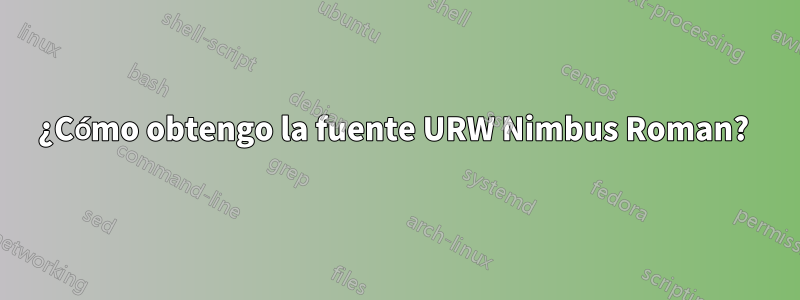
Me gusta mucho la fuente utilizada en este artículo y quiero usarla en mis documentos. ¿Alguien tiene alguna idea de cómo puedo hacerlo?
EDITAR: Descubrí que la fuente es URW Nimbus Roman (gracias por indicarme las publicaciones que me dicen cómo resolverlo). Entonces mi pregunta es ¿cómo puedo obtener esta fuente? ¿Qué paquetes tengo que cargar, etc.? ¡Lo siento, completo aficionado aquí! ¡Gracias por la ayuda!
Respuesta1
Se parece a Liberation Serif, una fuente que parece ser la opción predeterminada con LibreOffice en Mac, y es bastante similar en apariencia a Times New Roman.
XeLaTeX puede usar cualquiera de las fuentes de su sistema, por lo que si tiene instalada la fuente deseada, simplemente inclúyala en su documento como lo haría con cualquier otra fuente. Esto incluso se puede hacer por idioma. Por ejemplo, si desea utilizar la fuente Angsana New para el texto en tailandés en su documento, puede definirla de la siguiente manera:
\usepackage{polyglossia}
\setmainlanguage{english}
\setotherlanguage{thai}
\newfontfamily\thaifont[Script=Thai, Renderer=AAT]{Angsana New}
El uso del fontspecpaquete con XeTeX o LuaTeX también debería permitirle utilizar cualquier fuente TTF instalada en su sistema. Consulte aquí para obtener más información:Instalación de fuentes TTF en LaTeX
La fuente URW Nimbus Roman parece estar disponible para descargar desde aquí:https://www.fontsquirrel.com/fonts/nimbus-roman-no9-l
Respuesta2
Hay fuentes contenidas en TeXLive para la familia Nimbus (https://ctan.org/pkg/nimbus15). Cargarlos como complemento en lugar de otras soluciones podría ser más adecuado; lea la documentación.
\documentclass[]{article}
\usepackage{iftex}
\iftutex
%% LuaLaTeX or XeLaTeX
\usepackage{fontspec}
\setmainfont{ztm}
\else
%% pdfLaTeX
\usepackage{nimbusserif}
\fi
\begin{document}
\section{Introduction}
In this article I address the question whether, and if so in what sense, logic
can be said to have normative authority over reasoning. I claim that there is an
interesting sense in which logic can indeed be said to be normative for
reasoning. To substantiate my claim, I proceed as follows. I begin by laying
out Gilbert Harman's influential skeptical challenge to the thesis that logic
and norms of reasoning are interestingly related. According to Harman, once we
realize that principles of deductive logic are not nrms of reasoning in and of
themselves, a gap opens up between the two. Thus, a response to Harman's
challenge would consist in what John MacFarlane (2004) has fittingly dubbed a
`bridge principle'---a general principle articulating a substantive and
systematic link between logic
\end{document}
Resultado usando LuaLaTeX:




